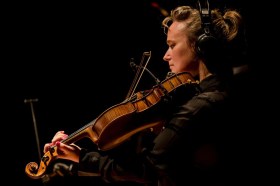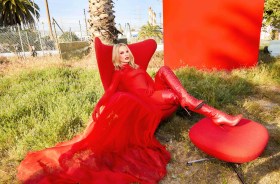From its origins in a Chicago nightclub way back in February 1971, there can’t have been many times that Grease The Musical hasn’t graced the stage somewhere, sometime. And why not? With an infectious score and a wafer-thin story that resonates like a gong, how could it not succeed?
Director Luke Joslin’s sparkling production for the indefatigable John Frost’s Crossroads Live is right up there with the best of the many productions we’ve seen over the years. (And Frost should know – he was tearing tickets at the first Australian production in 1972!) Joslin is on the record as saying he wanted something “fresh and bold” and he, and a crack team, deliver in spades.
More on the production later. For the majority of the eager audience in their slick 50s outfits, when this reviewer attended, it was all about the music. They ‘wella wella’ed’ in ‘Summer Nights’, they rocked in’ Greased Lightnin’, they crooned in ‘Hopelessly Devoted To You’ and they screamed their heads off in ‘You’re The One That I Want’ (‘ooh ooh ooh honey’).
You hardly need a cast, but happily the solid ensemble acquit themselves admirably. Fabian Andrés and Annelise Hall are a delight as Danny and Sandy, he with plenty of swagger and she with apple pie goodness – and both with solid music theatre chops, triple threats and all.
Grease gives the secondary characters plenty of opportunities to shine. Mackenzie Dunn’s brassy Rizzo is great fun, though not without a little vulnerability in ‘There Are Worse Things I Could Do’.
Grease gives the secondary characters plenty of opportunities to shine. Mackenzie Dunn’s brassy Rizzo is great fun, though not without a little vulnerability in There Are Worse Things I Could Do.
When this reviewer attended everyone was waiting for the featured stars to shine, and roars of applause greeted Patti Newton’s first entry as the (mostly) prim and proper Miss Lynch. Sixty-plus years in the business and she’s still singing up a storm.
In Act 2, the big guns come out and there were huge cheers for Jay Laga’aia (belting it out in real rocker style, even if he’s well outside of Play School bounds) and Paulini, whose ‘Teen Angel’ belter brought the house down, reminding us all that she’s one of Australia’s very best.
The production itself is terrific, plenty of colour, sensational costumes and a clever use of a versatile set, even if the revolve gets more work than the original Les Mis. There’s a red hot rod for ‘Greased Lightnin’ and glowing wings for the ‘Teen Angel’. The moves are brilliant, Eric Giancola’s choreography superbly staged by Madeleine Mackenzie.
Read: Theatre review: Chasing Dick: A Love Story, Theatre Works
The night may have been neither hot nor summery, but this production of Grease the Musical is a deserved and deserving crowd-pleaser.
Grease the Musical
John Frost for Crossroads Live
Her Majesty’s Theatre, Adelaide
Book, music and lyrics: Jim Jacobs and Warren Casey
Director: Luke Joslin
Choreography: Eric Giancola
Set, Costume and Wigs Design: James Browne
Lighting Design: Tudy Dalgleish
Sound Design: Michael Waters
Video Design: Craig Wilkinson
Resident Director: Trudy Dunn
Associate Choreographer: Madeleine Mackenzie
Technical Director: Frank Harlow
Music Supervision: Dave Skelton
Music Direction: Kohan van Sambeeck
Cast: Fabian Andrés, Annelise Hall, Mackenzie Dunn, Keanu Gonzales, Patti Newton, Jay Laga’aia (Bobby Fox in Brisbane), Paulini (Marcia Hines in Brisbane), Jordan Koulos, Catty Hamilton, Oliver Lacey, Katelin Koprivec, Regan Walker, Rose Shannon-Duhigg, Daniel Erbacher, Lachlan Beck, Oscar Bridges, Laura Joy Bunting, Olivia Carniato, Axel Duffy, Lucy Fraser, Gareth Isaac, Zoe Ioannou, Madeleine Mackenzie, Anna Mallows, Conor Putland, Samuel Welsh, Emma Whitfield
Grease the Musical will be performing at Her Majesty’s Theatre in Adelaide until 26 October 2024 and then moving to the Lyric Theatre at QPAC in Brisbane from 1 January to 1 February 2025.






